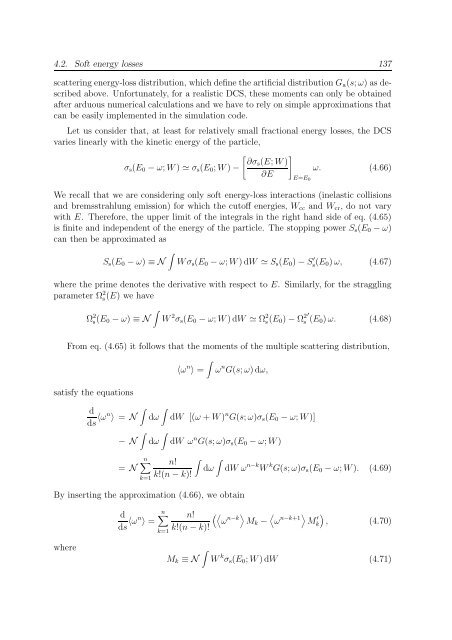PENELOPE 2003 - OECD Nuclear Energy Agency
PENELOPE 2003 - OECD Nuclear Energy Agency
PENELOPE 2003 - OECD Nuclear Energy Agency
Create successful ePaper yourself
Turn your PDF publications into a flip-book with our unique Google optimized e-Paper software.
4.2. Soft energy losses 137<br />
scattering energy-loss distribution, which define the artificial distribution G a (s; ω) as described<br />
above. Unfortunately, for a realistic DCS, these moments can only be obtained<br />
after arduous numerical calculations and we have to rely on simple approximations that<br />
can be easily implemented in the simulation code.<br />
Let us consider that, at least for relatively small fractional energy losses, the DCS<br />
varies linearly with the kinetic energy of the particle,<br />
σ s (E 0 − ω; W ) ≃ σ s (E 0 ; W ) −<br />
[ ]<br />
∂σs (E; W )<br />
∂E<br />
E=E 0<br />
ω. (4.66)<br />
We recall that we are considering only soft energy-loss interactions (inelastic collisions<br />
and bremsstrahlung emission) for which the cutoff energies, W cc and W cr , do not vary<br />
with E. Therefore, the upper limit of the integrals in the right hand side of eq. (4.65)<br />
is finite and independent of the energy of the particle. The stopping power S s (E 0 − ω)<br />
can then be approximated as<br />
∫<br />
S s (E 0 − ω) ≡ N W σ s (E 0 − ω; W ) dW ≃ S s (E 0 ) − S s ′ (E 0) ω, (4.67)<br />
where the prime denotes the derivative with respect to E. Similarly, for the straggling<br />
parameter Ω 2 s(E) we have<br />
∫<br />
Ω 2 s(E 0 − ω) ≡ N<br />
W 2 σ s (E 0 − ω; W ) dW ≃ Ω 2 s(E 0 ) − Ω 2′ s (E 0 ) ω. (4.68)<br />
From eq. (4.65) it follows that the moments of the multiple scattering distribution,<br />
∫<br />
〈ω n 〉 = ω n G(s; ω) dω,<br />
satisfy the equations<br />
∫<br />
d<br />
ds 〈ωn 〉 = N<br />
∫<br />
− N<br />
∫<br />
dω<br />
∫<br />
dω<br />
dW [(ω + W ) n G(s; ω)σ s (E 0 − ω; W )]<br />
dW ω n G(s; ω)σ s (E 0 − ω; W )<br />
= N<br />
n∑<br />
k=1<br />
∫<br />
n!<br />
k!(n − k)!<br />
∫<br />
dω<br />
dW ω n−k W k G(s; ω)σ s (E 0 − ω; W ). (4.69)<br />
By inserting the approximation (4.66), we obtain<br />
d<br />
ds 〈ωn 〉 =<br />
n∑<br />
k=1<br />
n! (〈 〉 ω<br />
n−k<br />
M k − 〈 ω n−k+1〉 )<br />
M k<br />
′ , (4.70)<br />
k!(n − k)!<br />
where<br />
∫<br />
M k ≡ N<br />
W k σ s (E 0 ; W ) dW (4.71)
















